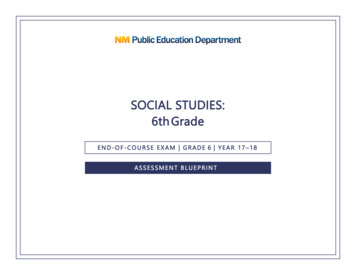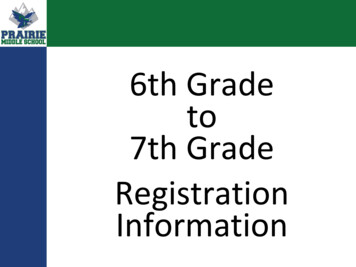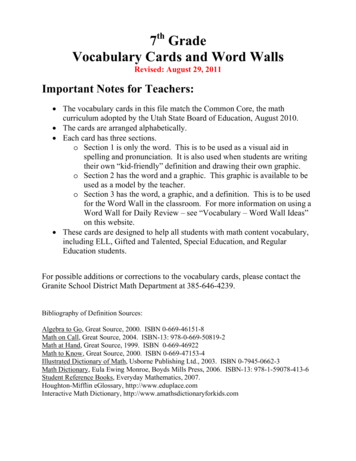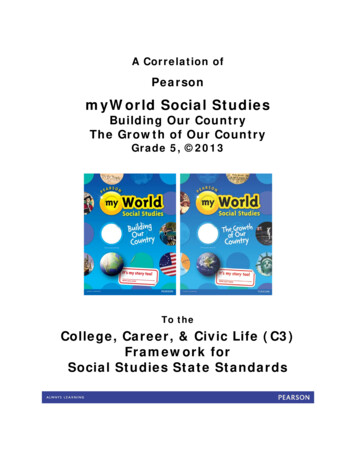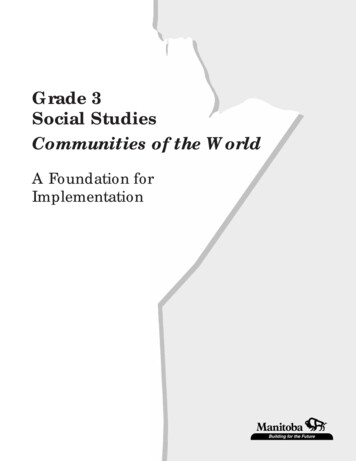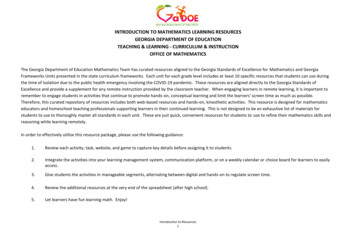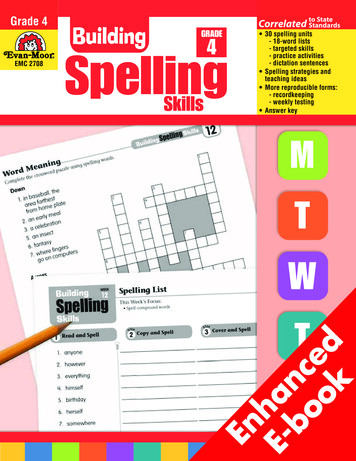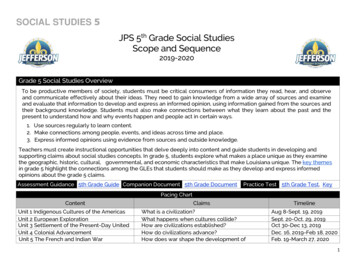
Transcription
6th GradeSocialStudies
Chapter 4: iLEAP Social Studies, Grade 6This section describes the overall design of the iLEAP Social Studies test to be administeredto students in grade 6. Test specifications and sample test questions are provided so thatteachers may align classroom practices with the state assessment.Test StructureThe Social Studies test consists of one part and is administered in a single day.The Social Studies test is a criterion-referenced test (CRT) that includes items based entirelyon Louisiana’s social studies content standards. These items are aligned with Louisiana’sGrade-Level Expectations (GLEs) and were developed specifically for Louisiana.Item TypesThe test has forty (40) multiple-choice items.The multiple-choice items consist of an interrogatory stem and four answer options. Theseitems assess knowledge, conceptual understanding, and application of skills presented in theGLEs. Items will be intermingled across strands, not arranged into separate sections bystrand.To maximize the meaningfulness of multiple-choice items, questions are typically cast in apractical problem-solving context, referring to a single stimulus (e.g., a map) or to adescription of a single scenario. The reading difficulty level of test questions is minimized tothe extent possible (except for necessary terms) so that students’ reading ability does notinterfere with their ability to demonstrate their social studies knowledge and skills.Description of the Social Studies TestThe Social Studies test was developed specifically for Louisiana. Committees of Louisianaeducators reviewed all items for content and alignment with Louisiana’s standards,benchmarks, and GLEs. Separate committees reviewed the items for potential bias andsensitive material.The Social Studies test is untimed. About one hour (60 minutes) is the suggested time toallow students to answer the questions.The grade 6 test assesses two of the four social studies strands delineated in the LouisianaComprehensive Curriculum (LCC) and the Louisiana Social Studies Framework: Geographyand History.HistoryThe GLEs for grade 6 focus on a comprehensive study of world history from thebeginnings of human activity through the fifteenth century and the period ofintensified hemispheric interaction. Students learn about the rise of agriculture andearly civilizations, the accomplishments and influence of such classical civilizationsiLEAP Assessment Guide4-1Social Studies Grade 6
as Greece and the Roman Empire, the elements and spread of major religions, and theinfluences that led to the Renaissance, the Reformation, and the Age of Exploration.Students continue to employ historical thinking skills in understanding and analyzingworld history.GeographyThe study of world history is integrally linked with the secondary focus of geography.The GLEs for grade 6 set expectations for students to use geographic information,tools, and concepts in learning about human settlement and migration, culturaldiffusion, the effect of the physical environment on human activity, and thedistribution and role of natural resources in world history.Students are also expected to apply economics concepts throughout their study ofworld history, while civics concepts are specifically addressed in their study ofancient Greece and the Roman Empire.Description of Stimulus MaterialThe test will incorporate at least one each of the following types of stimulus material: A map or illustration of a globe showing political divisions (e.g., states, countries),geographical features (e.g., topography, bodies of water), or variations in climate,vegetation, population density, etc. A table or graph presenting numerical data to be read or interpreted (e.g., a pictographor a pie or bar graph showing the breakdown of natural resources in a region or a linegraph showing rates of change over time) A timeline, chart, illustration, or graphic organizer (e.g., a web showing therelationship between world religions, a diagram showing the structure of the feudalsystem, or a timeline outlining the major accomplishments of a ruler) An excerpt or article from a newspaper or a magazine or a similar piece writtenexpressly for the test An excerpt from such primary sources as historical documents (e.g., the Magna Carta,the U.S. Constitution, the Code of Hammurabi), quotes and speeches, writings,journals, and autobiographies of major historical figures An excerpt from such secondary sources as reference books, literature, encyclopedias,artifacts, and nonfiction books about cultural, geographical, historical, political, oreconomic themesiLEAP Assessment Guide4-2Social Studies Grade 6
Scoring InformationThe iLEAP Social Studies test contains multiple-choice items only. These items have fourresponse options (A, B, C, D) and are scored right or wrong. Correct answers receive a scoreof 1; incorrect answers receive a score of 0.Social Studies Test SpecificationsTable 4.1 provides the test specifications for the grade 6 iLEAP Social Studies assessment.Table 4.1: Grade 6 Social Studies Test SpecificationsStrand/Category% of Total PointsGeographyA. The World in Spatial TermsB. Places and RegionsC. Physical and Human SystemsD. Environment and Society28History72A. Historical Thinking SkillsB. World HistoryTotal100Strands, Benchmarks, and GLEs AssessedLouisiana’s social studies content standards encompass four strands: Geography, Civics,Economics, and History. At grade 6, only two strands are taught and assessed: Geographyand History. Each benchmark within a standard delineates what students should know and beable to do at the end of a grade cluster.Strand G: Geography—Physical and Cultural SystemsStandard: Students develop a spatial understanding of Earth’s surface and theprocesses that shape it, the connections between people and places, and therelationship between man and his environment.Strand H: History—Time, Continuity, and ChangeStandard: Students develop a sense of historical time and historical perspective asthey study the history of their community, state, nation, and world.The GLEs for Social Studies further define the knowledge and skills students are expected tomaster by the end of each grade level or high school course. The GLEs for each grade aredevelopmentally appropriate and increase in complexity to build the knowledge and skillsthat students need. For example, the prekindergarten GLE “demonstrate an awareness oftime” begins the development of the concept “interpret data represented in a timeline toidentify change and continuity in world civilizations.” In subsequent grades, GLEs build onthis historical thinking skills concept.iLEAP Assessment Guide4-3Social Studies Grade 6
Most of the grade 6 GLEs are eligible for assessment on the iLEAP Social Studies test.Some, however, do not lend themselves to testing on a statewide assessment in multiplechoice format. For the Civics and Economics strands, GLE numbers 11, 12, 13, and 14 arenot directly measured by questions in the grade 6 iLEAP. In addition, GLE numbers 15, 17,18, 20, and 21 focus on historical thinking skills that require students to use outside resourcesunavailable during the test; therefore they cannot be assessed in a multiple-choice format.Finally, in accordance with the Comprehensive Curriculum, GLE numbers 45, 46, 47, 48, 49,50, and 52 may not be taught prior to the spring test administration and therefore will not beassessed. It is important, however, that the skills represented by these GLEs are taught at thisgrade level to prepare students for classroom assessment purposes as well as the grade 8LEAP test.Explanation of Codes:GLEs are numbered consecutively in each grade level and grouped by strand and thematiccategory. For example:Strand:Categories:GeographyA. The World in Spatial TermsB. Places and RegionsC. Physical and Human SystemsD. Environment and SocietyBenchmarks are organized into three or four thematic categories within each strand:Geography, Civics, Economics, and History. These categories (e.g., Places and Regions, orHistorical Thinking Skills) provide further content definition by highlighting the underlyingthemes within the domain of each strand.Benchmarks are coded by strand, standard, category, and grade cluster (E, M, H). The firstterm in the code always refers to the strand. The second term gives the standard number andcategory. The third term indicates the grade cluster and benchmark number. The fourth partindicates the GLE number.Table 4.2 provides two examples of benchmark codes.Table 4.2: Examples of Social Studies CodesCodeTranslationG-1B-E1-16Geography, Standard 1, Category B, Elementary Benchmark 1,GLE 16H-1A-H3-9History, Standard 1, Category A, High School Benchmark 3, GLE 9iLEAP Assessment Guide4-4Social Studies Grade 6
Key Concepts for the Grade 6 AssessmentThe key concepts are provided to guide teachers in their classroom instruction as it relates tothe assessment. These concepts describe important content emphasis regarding theknowledge and skills eligible for assessment of each strand.GeographyThe World in Spatial Terms Lines of latitude (parallels) and lines of longitude (meridians) to locate or comparepoints on a map or representation of a globe Cardinal directions and intermediate directions—NE, NW, SE, SW The equator and prime meridianPlaces and Regions Land and climatic conditions conducive to human settlement—e.g., fresh water,fertile soil, mild climate, location near body of water Role of slash-and-burn farming Physical features that have influenced world historical events—e.g., Nile River, Tigrisand Euphrates Rivers (“Land between Two Rivers”), Red Sea, Sahara Desert, IndusRiver, Alps Mountains, Sinai Peninsula, Himalaya Mountains, Gobi Desert, Beringland bridge Cultural goals and interests, inventions, and technological advances that have affectedpeople’s perception and use of world regions—e.g., spread of the Islamic Empire,religious conflict in Jerusalem and Israel, development in the Fertile Crescent,agricultural innovations such as terrace farming and the plowPhysical and Human Systems Reasons for early migrations—e.g., search for sources of food and water, severeclimate changes such as flood or drought, increased opportunity for trade, escapefrom religious or political persecution Physical features that have discouraged migrations of peoples—e.g., mountains,deserts, waterfalls Historical migration routes Factors that have made cultural diffusion possible—e.g., trade by the Phoeniciansand spread of their alphabet, spread of the Islamic Empire Historical events and trade routes that led to the distribution of culture—e.g.,European exploration, Crusades, Silk Road, Constantinople, Mediterranean Sea Trade of goods and services that encouraged economic interdependence amongancient civilizations—e.g., cotton, papyrus, silk, wood, spices, pottery, ivory, copper Ancient centers of trade—e.g., Mycenae, Egypt, China, Mediterranean nations,Mesopotamia, Indus River Valley Political borders established by ancient civilizations—e.g., natural boundaries suchas deserts, bodies of water and mountains, and man-made boundaries such as wallsiLEAP Assessment Guide4-5Social Studies Grade 6
Environment and Society Effect of physical environments on human activity in ancient civilizations—e.g.,flood plains, deserts, rain forests Human adaptations of physical environment—e.g., levees and dams, irrigation,canals, trading, growing crops native to environment Characteristics of hunter-gatherers and desert nomadsHistoryHistorical Thinking Skills Interpret chronology of dates as presented on vertical and horizontal timelines Understand that data presented in a timeline represents elapsed time between andwithin elapsed time periods Describe change and continuity over time Identify and interpret primary source material—e.g., quotes, literature, artifacts Distinguish the difference between a primary and secondary sourceWorld History Hunter-gatherer societies—e.g., wandering and nomadic lifestyle, types of foodhunted, use of animals for clothing and shelter Building materials used by early civilizations—e.g., Mesopotamia, NativeAmericans Development of early tools and materials used to create them Natural resources important to the development of agriculture in earlycivilizations—e.g., availability of fresh water supply, rich soil, temperate climate Physical barriers that provided ancient civilizations protection Development of agricultural societies from hunters and gatherers—e.g.,domestication and cultivation, Agricultural Revolution, shortage of available food Reasons for the domestication of plants and animals Major climatic changes which led to domestication Location and characteristics of major river systems—e.g., Tigris and EuphratesRivers, Indus River, Nile River, Huang-He River (“River of Sorrows”) Characteristics of the major early river valley civilizationso Mesopotamia—e.g., ziggurats, Code of Hammurabi, Sumerian city-states,cuneiformo Egypt—e.g., rule by pharaohs, pyramids and mummification, hieroglyphics,irrigation methods, papyruso Indus Valley—e.g., planned cities of Mohenjo-Daro and Harappa, monsoonwinds, agricultural society, caste systemo China—e.g., ideographs, warrior class, Mandate of Heaven/ rule by dynasty,silk Trade of goods and spread of ideas between early river valley civilizations Development of agricultural societies in Southwest Asia, the Mediterranean Basin,and temperate Europe—e.g., methods of food storage, agricultural developmentssuch as irrigation techniques and the plow and their impact, increase of structuredgovernments and defined leadersiLEAP Assessment Guide4-6Social Studies Grade 6
Military migrations and invasions in Europe and Asia—e.g., Spartans, Hyskos,Aryans, Hittites, DoriansOrigins and influence of the Hittite, Minoan, and Mycenaean civilizationsIntroduction of iron tools and weapons in Southwest Asia and the Mediterraneanregion—e.g., metal plow, increased military activityPhoenician trade in the Mediterranean Basin—e.g., important trading partners suchas Egypt and Greece, exchange of goods and information such as phonetic alphabet,indigo dye and cloth, nautical and shipbuilding skillsForms of writing developed in early civilizations—e.g., Greek alphabet, Egyptianhieroglyphics, Chinese symbols, Indus Valley pictographsCultural achievements of Greece—e.g., establishment of direct democracy inAthens, architecture, polis, literature such as epic poems and playsAlexander the Great—e.g., education and ancestry, expansion of the Greek empirethrough military conquests (location and methods), spread of Greek culture intoAsiaInfluence of Greek ideas about democracy on the Roman Republic and their impacton the founders of the United StatesKey characteristics of classical civilizations—e.g., accomplishments in science andengineering, architecture, major goods traded, writing system, language, religiousbeliefsCompare and contrast the major religions that emerged in the Mediterranean Basin,China, and India (Islam, Judaism, Christianity, Buddhism, Hinduism)—e.g.,location, key beliefs, holy books, holy sites, leaders and founders, common moralbeliefs, symbolsSpread of major religions and cultural traditions—e.g., spread of Islamic empire andChristianity, Emperor Constantine, effect of Roman Crusades, Jewish migrationEffect of major religions on European, Asian, and African civilizations—e.g.,influence of Roman Catholic Church in medieval Europe, architecture of places ofworship, religious motivation for European explorations, caste system of IndiaDevelopments brought about by the emergence and collapse of major kingdomsprior to A.D. 1000—e.g., divide of the Roman Empire, romance languages, Goths,expansion of Arabic cultureMajor events, key figures, and social structure of the Early Middle Ages—e.g.,feudalism (vassals, serfs, knights, priests, lords, manors), effects of the plague, fallof Rome, accomplishments of CharlemagneMajor innovations in shipbuilding, navigation, and naval warfare—e.g., cannon,telescope, magnetic compass, astrolabe, lateen sail, frigate, galleon, caravelAccomplishments of Prince Henry the NavigatoriLEAP Assessment Guide4-7Social Studies Grade 6
Grade 6 Social Studies Standards, Benchmarks, and GLEsThe following chart presents all grade 6 Social Studies standards, benchmarks, and GLEs.GRADE 6SOCIAL STUDIES STANDARDS, BENCHMARKS, AND GLESGeography—Physical and Cultural Systems: Students develop a spatial understanding of Earth’ssurface and the processes that shape it, the connections between people and places, and therelationship between man and his environment.A. The World in Spatial TermsBenchmarksGrade-Level ExpectationsG-1A-M1: identifying and describing thecharacteristics, functions, and applications ofvarious types of maps and other geographicrepresentations, tools, and technologiesG-1A-M2: interpreting and developing maps,globes, graphs, charts, models, and databases toanalyze spatial distributions and patterns1. Use latitude and longitude to determinedirection or locate or compare points on a mapor representation of a globe (G-1A-M2)G-1A-M3: organizing and displaying informationabout the location of geographic features and placesby using mental mapping skillsB. Places and RegionsG-1B-M1: explaining and analyzing both thephysical and human phenomena associated withspecific places, including precipitation andsettlement patterns2. Identify land and climatic conditions conduciveto human settlement in regions of the world anddescribe the role of these conditions (G-1B-M1)G-1B-M2: identifying and describing significantphysical features that have influenced historicalevents3. Identify physical features that influenced worldhistorical events and describe their influence(e.g., the Nile and Tigris-Euphrates as “cradlesof civilization”) (G-1B-M2)G-1B-M3: identifying criteria used to defineregions and explaining how and why regions changeG-1B-M4: describing and explaining how personalinterests, culture, and technology affect people’sperceptions and uses of places and regions4. Explain ways in which goals, cultures, interests,inventions, and technological advances haveaffected people’s perceptions and uses of placesor regions in world history (G-1B-M4)C. Physical and Human SystemsG-1C-M1: predicting and explaining how physicalfeatures help to shape patterns and arrangements inthe physical environmentG-1C-M2: identifying key demographic conceptsand using these concepts to analyze the populationcharacteristics of a country or regioniLEAP Assessment Guide4-8Social Studies Grade 6
G-1C-M3: describing the characteristics andpatterns of human settlement in different regions ofthe world and analyzing the impact of urbanizationG-1C-M4: analyzing types, patterns, and effects ofhuman migration over time5. Explain reasons for different patterns ofmigration among early peoples (G-1C-M4)G-1C-M5: tracing local and worldwide patterns ofcultural diffusion and analyzing their causes andeffects6. Explain factors or events that have facilitatedcultural diffusion (e.g., the Silk Road, Crusades)(G-1C-M5)G-1C-M6: comparing historical and contemporarypatterns of economic interdependence7. Describe the economic interdependence amongvarious ancient civilizations (G-1C-M6)G-1C-M7: explaining how cooperation and conflictamong people contribute to the political divisionson Earth’s surface8. Explain how ancient civilizations establishedand maintained political boundaries (G-1C-M7)D. Environment and SocietyG-1D-M1: analyzing and evaluating the effects ofhuman actions upon the physical environmentG-1D-M2: explaining and giving examples of howcharacteristics of different physical environmentsaffect human activities9. Explain how different physical environmentsaffected human activity in ancient civilizations(G-1D-M2)G-1D-M3: analyzing the worldwide distributionand utilization of natural resources10. Analyze world or regional distribution ofnatural resources in terms of the need to importor the capacity to export (G-1D-M3)G-1D-M4: identifying problems that relate tocontemporary geographic issues and researchingpossible solutionsCivics—Citizenship and Government: Students develop an understanding of the structure andpurposes of government, the foundations of the American democratic system, and the role of theUnited States in the world, while learning about the rights and responsibilities of citizenship.A. Structure and Purposes of GovernmentThere are no Grade-Level Expectations for benchmarks in grade 6 for this category.B. Foundations of the American Political SystemC-1B-M1: explaining the essential ideas andhistorical origins of American constitutionalgovernment11. Identify the essential elements of Greek andRoman government that would later influencethe U.S. government (C-1B-M1)C-1B-M2: identifying and describing the historicalexperiences and the geographic, social, andeconomic factors that have helped to shapeAmerican political cultureC-1B-M3: explaining the meaning and importanceof basic principles of American constitutionaldemocracy as reflected in core documentsC-1B-M4: analyzing the ways in which politicaland social conflict can be peacefully resolvedC-1B-M5: analyzing democratic processes used toinstitute changeiLEAP Assessment Guide4-9Social Studies Grade 6
C-1B-M6: analyzing the importance of politicalparties, campaigns, and elections in the Americanpolitical systemC. International RelationshipsThere are no Grade-Level Expectations for benchmarks in grade 6 for this category.D. Roles of the CitizenThere are no Grade-Level Expectations for benchmarks in grade 6 for this category.Economics—Interdependence and Decision Making: Students develop an understanding offundamental economic concepts as they apply to the interdependence and decision making ofindividuals, households, businesses, and governments in the United States and the world.A. Fundamental Economic ConceptsBenchmarksGrade-Level ExpectationsE-1A-M1: describing how the scarcity of resourcesnecessitates decision making at both personal andsocietal levelsE-1A-M2: analyzing consequences of economicdecisions in terms of additional benefits andadditional costsE-1A-M3: analyzing the consequences andopportunity cost of economic decisionsE-1A-M4: analyzing the role of specialization inthe economic process12. Explain the role of expanding specialization inthe development of world civilizations(E-1A-M4)E-1A-M5: giving examples of how skills andknowledge increase productivity and careeropportunitiesE-1A-M6: describing the essential differences inthe production and allocation of goods and servicesin traditional, command, and market systemsE-1A-M7: describing the various institutions, suchas business firms and government agencies, thatmake up economic systemsE-1A-M8: differentiating among various forms ofexchange and money13. Identify the functions and characteristics ofmoney (e.g., money as a store of value) andcompare barter exchange to money exchange(E-1A-M8)E-1A-M9: using economic concepts to help explainhistoric and contemporary events and developments14. Use economic concepts (e.g., supply anddemand, interdependence) to describe theeconomic motivations for expanding trade andterritorial domination in world history(E-1A-M9)iLEAP Assessment Guide4-10Social Studies Grade 6
B. Individuals, Households, Businesses, and GovernmentsThere are no Grade-Level Expectations for benchmarks in grade 6 for this category.C. The Economy as a WholeThere are no Grade-Level Expectations for benchmarks in grade 6 for this category.History—Time, Continuity, and Change: Students develop a sense of historical time and historicalperspective as they study the history of their community, state, nation, and world.A. Historical Thinking SkillsBenchmarksGrade-Level ExpectationsH-1A-M1: describing chronological relationshipsand patterns15. Construct a timeline of key developments inworld history (political, social, technological,religious/cultural) (H-1A-M1)16. Interpret data presented in a timeline to identifychange and continuity in world civilizations(H-1A-M1)H-1A-M2: demonstrating historical perspectivethrough the political, social, and economic contextin which an event or idea occurred17. Describe the defining characteristics of majorworld civilizations from political, social, andeconomic perspectives (H-1A-M2)H-1A-M3: analyzing the impact that specificindividuals, ideas, events, and decisions had on thecourse of history18. Describe the causes, effects, or impact of agiven historical development or event in worldcivilizations (H-1A-M3)H-1A-M4: analyzing historical data using primaryand secondary sources19. Use multiple primary and secondary sources todescribe world civilizations (H-1A-M4)H-1A-M5: identifying issues and problems from thepast and evaluating alternative courses of action20. Identify historical issues or problems in worldcivilizations and discuss how they wereaddressed (H-1A-M5)H-1A-M6: conducting research in efforts to answerhistorical questions21. Conduct historical research using a variety ofresources to answer historical questions relatedto world civilizations (H-1A-M6)B. United States HistoryThere are no Grade-Level Expectations for benchmarks in grade 6 for this category.C. World HistoryH-1C-M1: describing the earliest humancommunitiesiLEAP Assessment Guide22. Describe features of the earliest communities(e.g., shelter, food, clothing) (H-1C-M1)23. Describe hunter-gatherer societies, including thedevelopment of tools and the use of fire(H-1C-M1)4-11Social Studies Grade 6
H-1C-M2: explaining the emergence of agriculturalsocieties around the world24. Explain how geographical features influenceddevelopment of early civilizations (e.g.,domestication, cultivation, specialization)(H-1C-M2)25. Explain why agricultural societies developedfrom hunters and gatherers (H-1C-M2)26. Discuss the climatic changes and humanmodifications of the physical environment thatgave rise to the domestication of plants andanimals and new sources of clothing (H-1C-M2)H-1C-M3: identifying the major characteristics ofearly civilizations in Mesopotamia, Egypt, and theIndus valley27. Locate and describe the major river systems anddiscuss the physical settings that supportedpermanent settlement and early civilizations inMesopotamia, Egypt, China, and the Indusvalley (H-1C-M3)28. Describe the major characteristics of early rivervalley civilizations (H-1C-M3)H-1C-M4: tracing the development and expansionof agricultural societies and the emergence of newstates29. Describe how early river civilizationsinfluenced the development of other culturesthrough trade and cultural diffusion (H-1C-M4)30. Describe the development of agriculturalsocieties and individual communities inSouthwest Asia, the Mediterranean Basin, andtemperate Europe, including the role of plowtechnology (H-1C-M4)H-1C-M5: analyzing the political, social, andcultural consequences of population movements andmilitarization in Europe and Asia31. Identify the effects of migration andmilitarization on the politics and social fabric ofEurope and Asia (H-1C-M5)32. Analyze the origins and influence of the Hittite,Minoan, and Mycenaean civilizations(H-1C-M5)H-1C-M6: discussing and giving examples oftechnological and cultural innovation and change33. Explain the significance of the introduction ofiron tools and weapons in Southwest Asia andthe Mediterranean region (H-1C-M6)34. Explain the significance of Phoenician trade inthe Mediterranean Basin (H-1C-M6)35. Identify forms of writing developed in earlycivilizations and discuss how written recordschanged political, legal, religious, and culturallife (H-1C-M6)H-1C-M7: describing the classical civilizations andexamining their interactions and influences36. Describe the development of the Greek citystates, the cultural achievements of Athens, andthe impact of Alexander the Great’s conquests(H-1C-M7)37. Explain the sharing of ideas, goods, and servicesthrough trade between the Greek and Romancivilizations, and the influence of thosecivilizations on other cultures (H-1C-M7)38. Describe and compare/contrast the keycharacteristics of classical civilizations (e.g.,Greek, Roman, Persian, Chinese) (H-1C-M7)iLEAP Assessment Guide4-12Social Studies Grade 6
H-1C-M8: describing and comparing theemergence of major religions and large-scaleempires in the Mediterranean Basin, China, andIndia39. Identify the major new religions and relate themto the empires that emerged in theMediterranean Basin, China, and India (i.e.,Christianity, Hinduism, Buddhism, Islam)(H-1C-M8)40. Compare and contrast the major religions interms of leaders, key beliefs, and location(H-1C-M8)H-1C-M9: tracing the expansion of major religionsand cultural traditions and examining the impact oncivilizations in Europe, Asia, and Africa41. Trace the spread of major religions and culturaltraditions (e.g., the migration of Jews, spread ofChristianity, expansion of Islamic rule)(H-1C-M9)42. Identify the effect that the major religions havehad on European, Asian, and Africancivilizations (H-1C-M9)H-1C-M10: analyzing the political, social, andcultural developments and changes that resultedfrom the rise and fall of empires and kingdoms inEurope, Asia, Africa, and the Americas43. Describe the changes and developments broughtabout by the emergence and collapse of majorempires/kingdoms in Europe, Asia, Africa, andthe Americas prior to A.D. 1000 (H-1C-M10)44. Describe major events, key figures, and socialstructure of the Early Middle Ages (e.g., the fallof Rome, Charlemagne, feudalism) (H-1C-M10)H-1C-M11: analyzing the cultural and economicimpact of the interregional system ofcommunication and trade that developed among thepeoples of Europe, Asia, and Africa45. Identify effects of exploration and trade on theeconomic and cultural development of Europe,Africa, and Asia prior to 1500 (H-1C-M11)46. Explain how communication among regionswas accomplished between A.D 1000 and 1500(H-1C-
The Social Studies test consists of one part and is administered in a single day. The Social Studies test is a criterion-referenced test (CRT) that includes items based entirely on Louisiana's social studies content standards. These items are aligned with Louisiana's Grade-Level Expectations (GLEs) and were developed specifically for Louisiana.
